Toronto is about as urban as Canada gets. As the country’s most populous city, Toronto is diverse, vibrant and filled with things to see and do. In this post, we’ll explore 10 of the best things to do in Toronto. We’ll explain what they are, how to see them, and tips we’ve learned from experience.
Keep reading to start planning your trip to Toronto!
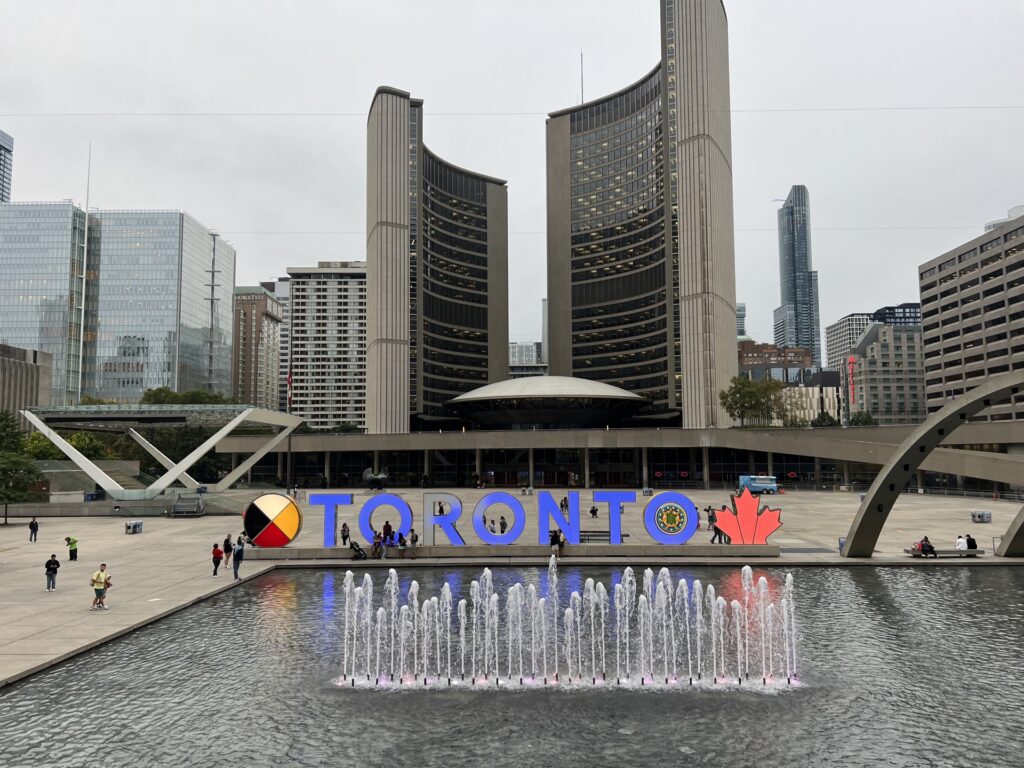
In This Post
- Where to Stay in Toronto
- How Long to Stay in Toronto
- Getting Around Toronto
- Best Things to do in Toronto
- Sample Toronto Itinerary
- Tips for Visiting Toronto
Where to Stay in Toronto
There are a few different areas to stay in Toronto, but I’ll narrow it down to two neighborhoods.
For a luxury stay, look to Yorkville. This is a high-end neighborhood on the north end of downtown Toronto. Here you’ll find two of the best hotels in the city — The Hazelton Hotel and the Four Seasons Hotel Toronto — just up the road from each other.
Yorkville is a great neighborhood with lots of shopping and excellent restaurants within walking distance. The neighborhood is so charming that it’s actually listed below as one of the best things to do in Toronto. The only downside to Yorkville is that it’s a bit of a hike from most other tourist attractions in the city. If you stay in this neighborhood, you’ll have to take the train to just about everywhere else.
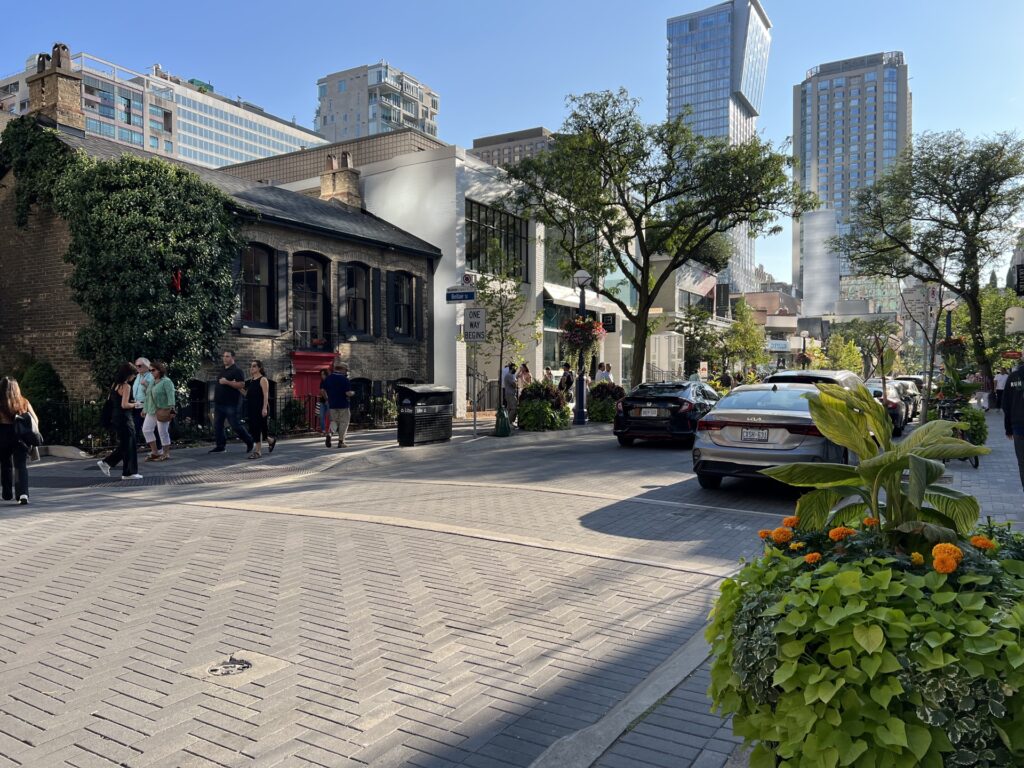
For a more central location and wider variety of price points, look to the financial and entertainment district. This is the area around Union Station (roughly bordered by the train tracks on the south, Spadina Avenue to the west, Queen Street to the north, and Yonge Street to the east). This area has the densest selection of hotels, ranging from the Hilton Toronto to the Ritz-Carlton.
If you stay in this area, you’ll be within walking distance to many of the city’s top attractions. There is still plenty of shopping and dining nearby, but with more of an urban feel. You will also be close to Union Station, which means transportation around the city, to and from the airport, and any day trips will be much easier.
Personally, we stayed at the Four Seasons. We loved the hotel, but that’s not surprising. (It’s a very nice hotel.) The neighborhood itself was lovely and very walkable, which we very much enjoyed. However, but we did grow frustrated taking the train to every other place we wanted to go. In hindsight, I’d probably have stayed closer to Union Station knowing all the things we wanted to do in that area.
How Long to Stay in Toronto
Toronto is an urban destination that has plenty of entertainment districts, shopping streets, museums and parks to keep you busy for a while. But since you likely won’t have infinite time to spend in Toronto, here’s a realistic look at how long you should stay.
- Stay in Toronto for two days if … you just want to see a few of the best city sites. It can be a great weekend destination or you can pair it with another city in Canada for a longer trip.
- Stay in Toronto for 3 days if … you want to take a day trip to Niagara Falls.
- Stay in Toronto for 4 days if … you want to see most of the city’s best sites and Niagara Falls.
- Stay in Toronto for 5+ days if … you want to do all of the above at a relaxed pace.
As a general rule of thumb, I would say that 3 days is a perfect about of time to spend in Toronto. You’ll have time to see most of the things you want to see, without getting bored. You’ll have time for a day trip if you want, or you can just take things a bit slower.

Getting Around Toronto
Toronto’s downtown core is pretty well connected by public transit. The city has four metro train lines, a web of streetcar routes, and buses to supplement everything else.
The metro trains in Toronto were pretty straight forward. You can tap-to-pay with a credit card to board the train, and no special ticket is required. The trains in Toronto were always busy and ran frequently. We generally had a positive experience with the Toronto metro. (Except for that one time someone dropped and shattered a crack pipe inches from our toddler. #citylife)
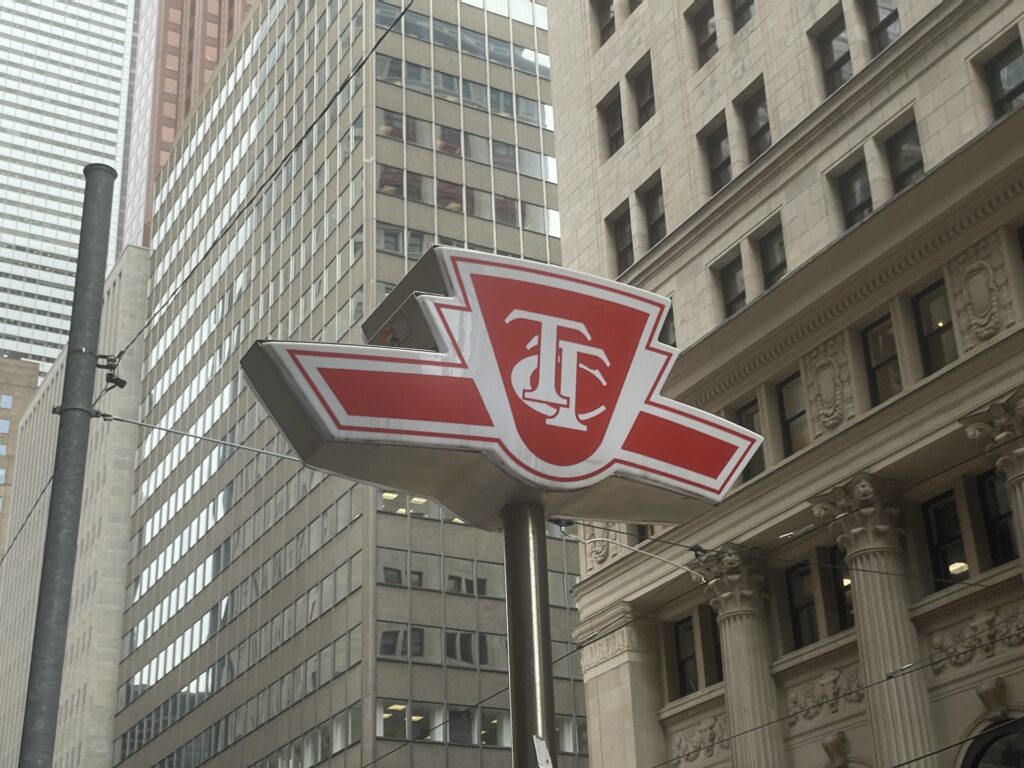
While there are four routes, most tourists will only need to worry about one. The Yonge-University line (yellow) is the main line around town. In runs in a U-shape, with Union Station at the bottom of the U. When you board the train at Union Station, you’ll need to know if you’re going northwest to Vaughan Metropolitan Centre or northeast to Finch Street. Otherwise, you’ll just need to know if you’re going downtown to Union Station or the other way.
A broader portion of downtown Toronto is served by streetcars. The streetcars are somewhere between a train and a bus. They look like a train with more cars and seating, but they run above ground along dedicated tracks in the middle of the street. We’re big fans of streetcars and found Toronto’s to be very efficient. You can board the streetcar from any door and then tap-to-pay with a credit card on the kiosk near each door.
We didn’t need to take any buses, but they’re available. Buses in Toronto are also tap-to-pay.
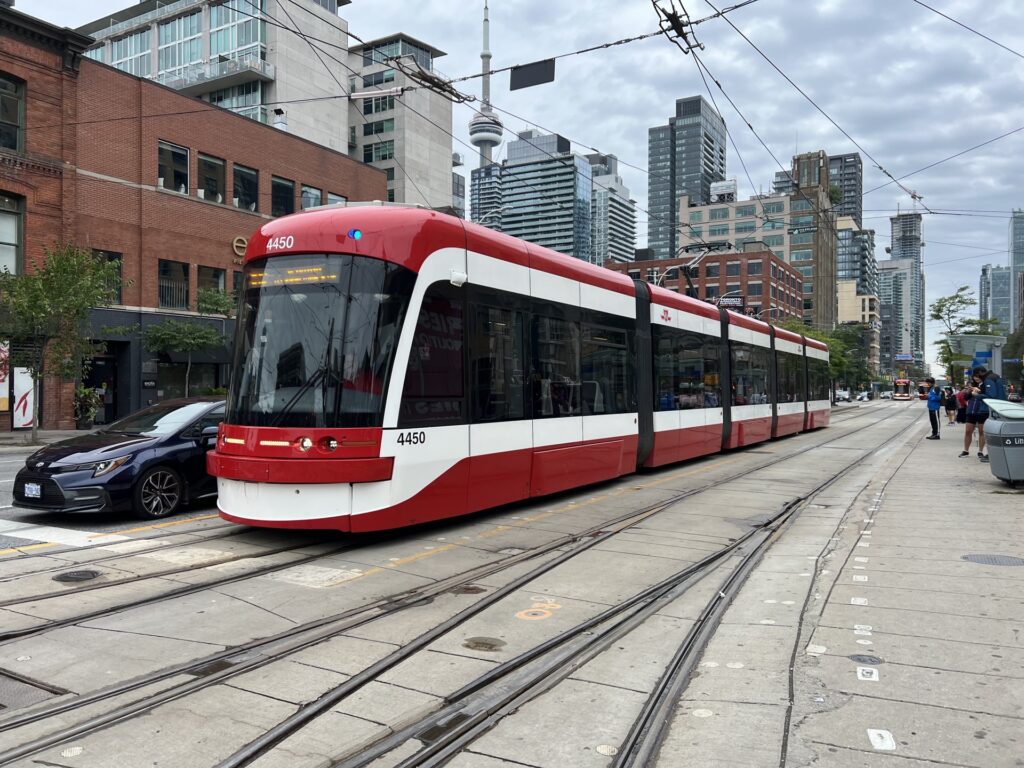
Getting to & from the Toronto Airport
Toronto Pearson International Airport is connected to downtown Toronto via the UP Express.
From the airport, follow signs that say “Trains to the City.” The station was about a 10 minute walk from our gate, all inside the airport. There are ticket kiosks near the station, which accept credit cards and Canadian cash. Tickets for the train cost $12.35 CAD.
The train runs from the airport to the city every 15 minutes from 5:30 AM (6:30 AM on weekends and holidays) to 11:30 PM. The ride takes about 25 minutes and ends at Union Station. From Union Station, you can connect to the Yonge-University Metro if needed.
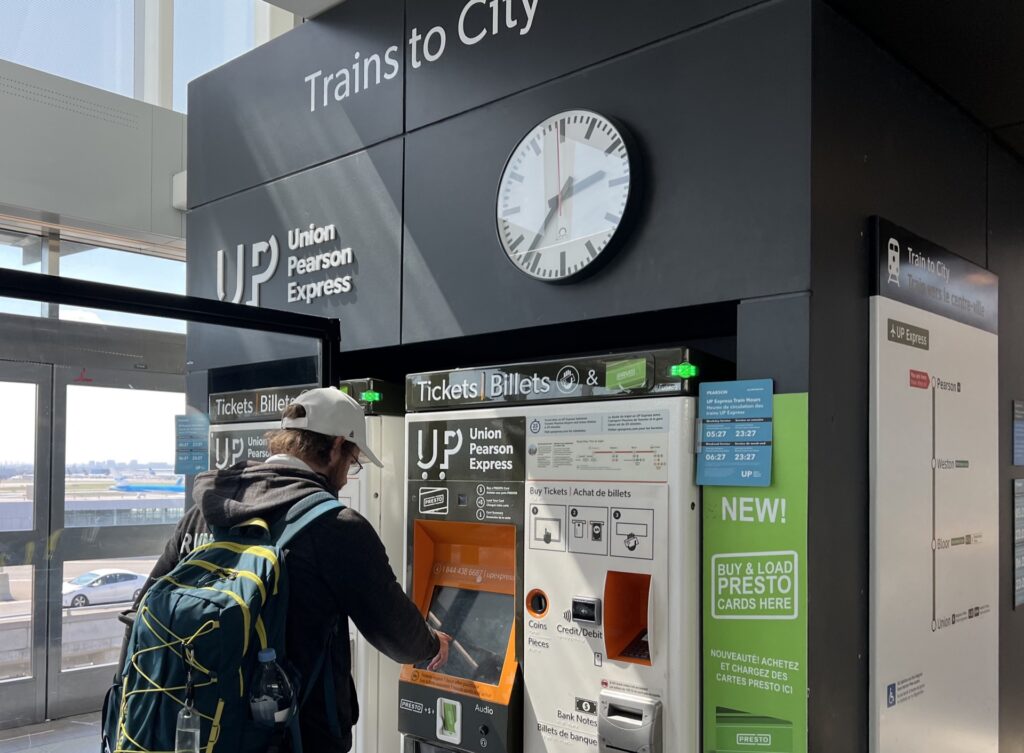
10 Best Things to do in Toronto
Toronto is a big city that has a wide variety of sites and attractions. We’ve compiled the 10 best things to do in Toronto in the list below, including all the details you’ll need to enjoy each one. This list is great for first-time visitors to Toronto who want to get a good feel of what the city has to offer.
1. Roundhouse Park & Toronto Railway Museum
- What is it: This is an old train yard that has been converted into a park. There’s a museum, brewery, gift shop, train ride, and playground in the park.
- How to get there: Take the Yonge-University metro line to Union Station and then walk 15 minutes.
- How much does it cost: It’s free to enter the park and see the trains outside. The museum costs $14 CAD ($5 CAD children 4-16). The train ride costs $5 CAD per person.
- How long does it take: 1 hour (+ longer if you plan to eat there.)
- When is it open: The museum is open year round Wednesday – Sunday from 12 – 5 PM. The train ride only runs from mid-June through Labour Day from 12 – 5, with ticket sales starting at 11:30 AM.
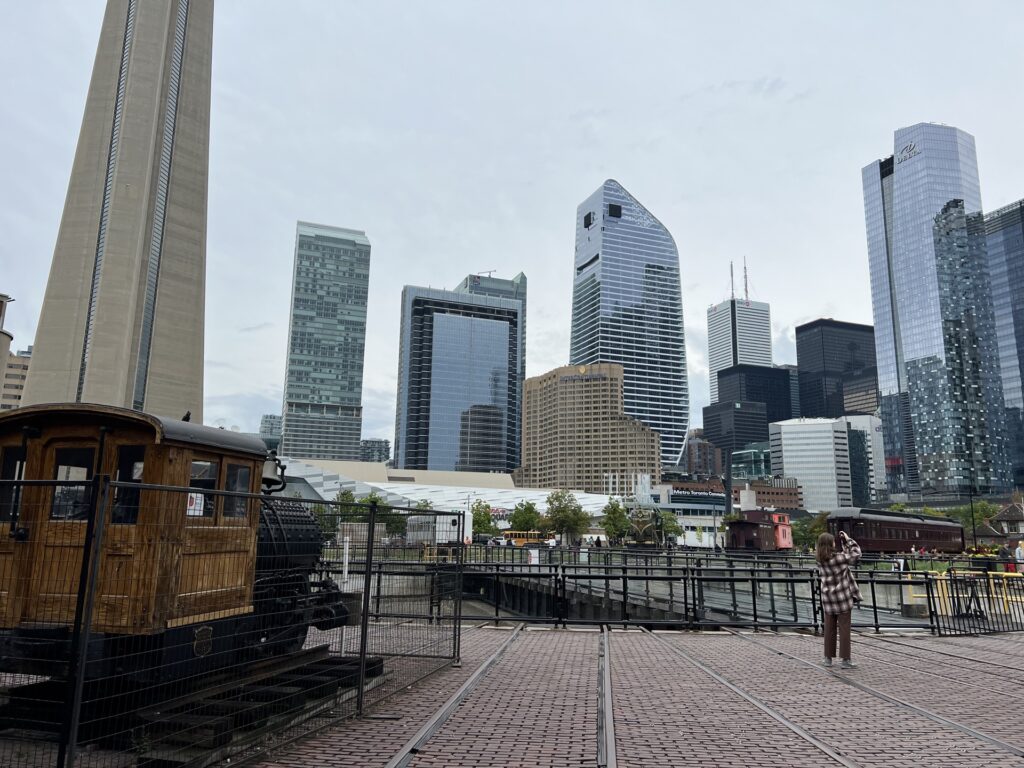
Roundhouse Park is built around an old railway roundhouse and turn table. Any child who has watched Thomas & Friends (or any adult who still loves trains) is going to be thrilled to see one of these turn tables in real life. Outside of the roundhouse is a collection of old trains, which you can see from the park at anytime. (You can’t go inside them.)
The most popular attraction in the park is the mini steam train on the east end of the park. Tickets go on sale at 11:30 at Don Station and are sold for a specific time. Each train only sits a limited number of people, and it runs every 20 minutes or so. If you’re late in the queue, it might be a few hours before your boarding time. They also are known to sell out quickly for the full day. Plan to be there at 11:30 to ensure you get tickets and can ride quickly.
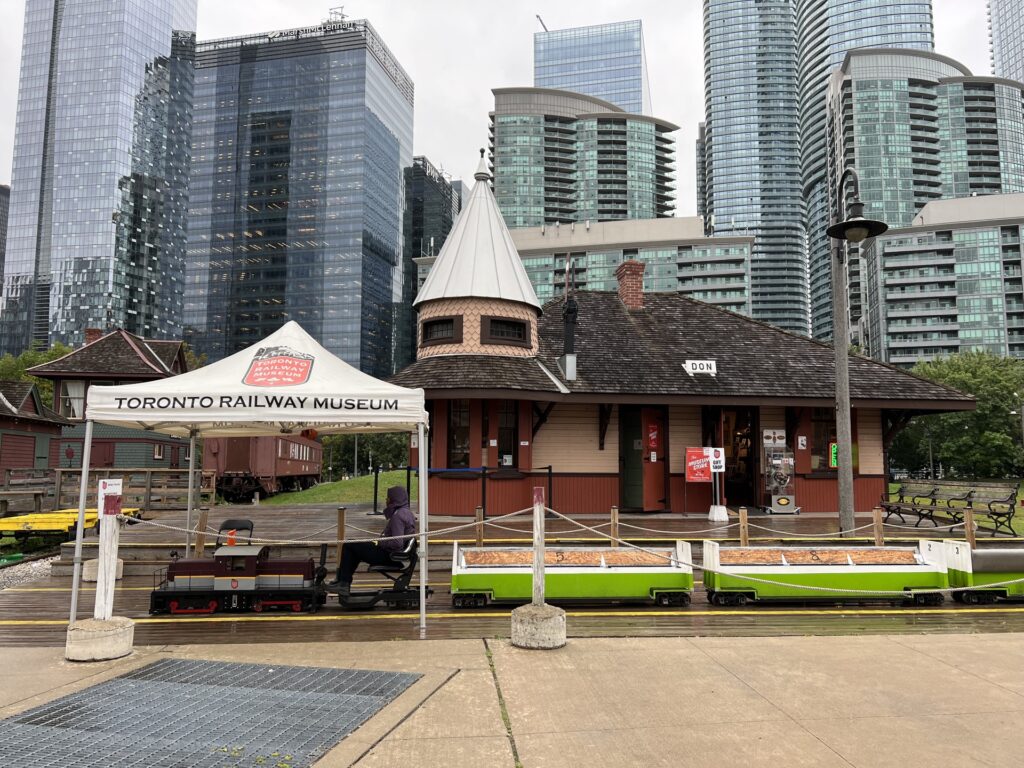

If you have time to kill while you wait, there is the museum, playground and brewery in the park to keep you busy.
Inside one of the old train sheds is a small railway museum. The museum has one train car inside, a VR experience where you can pretend to drive a train, a single room with some information and models, and then a kids play area with wooden trains and some crafts.
TIP: Check the craft table for a bingo card! If you look around to find the items, you can earn a small prize at the end.
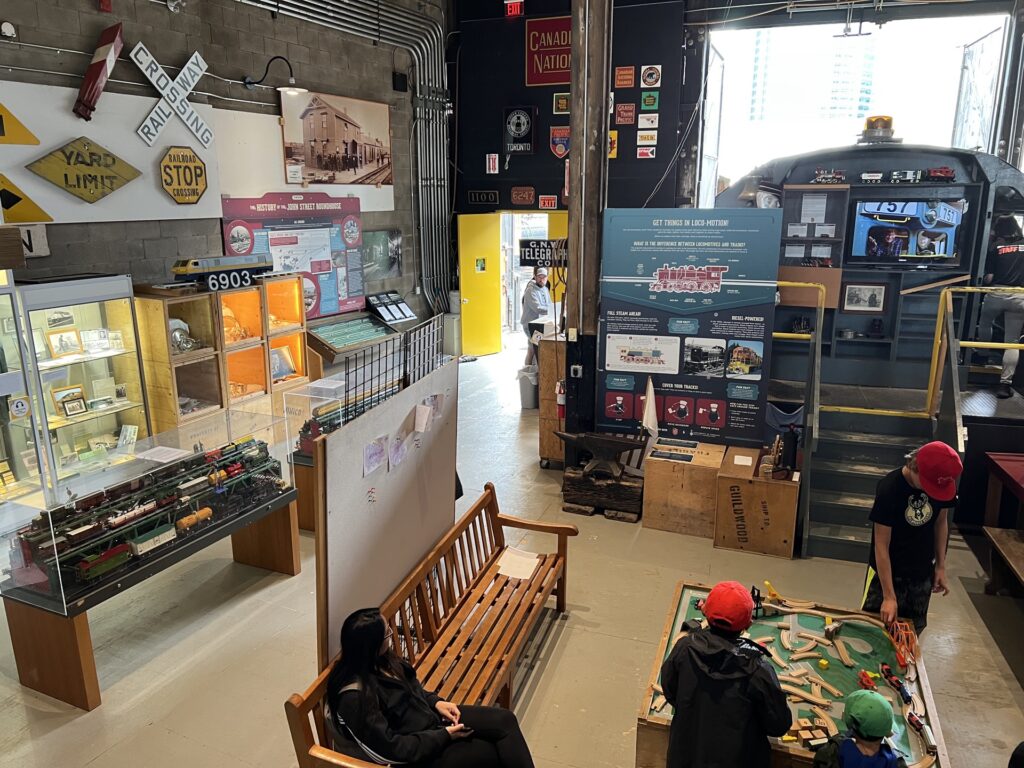
Steam Whistle Tap Room is a brewery / restaurant inside the park. Despite being a brewery, it’s incredibly kid friendly. During our lunchtime visit, every single table had a child. They have a kids menu (with a vegan hot dog option!) and plenty of highchairs. It’s honestly perfect. I suspect it gets quite crowded later in the day, so I’d suggest you eat right around the time they open so you don’t have to wait for a table.
Lastly, there’s a small playground at the southeast corner of the park. It’s nothing to write home about, but it has nice skyline views and is a great place to hang out while you’re waiting for your train time. Trains do start to board about 10 minutes before the scheduled time, so don’t wait too long to head over.
2. Yorkville
- What is it: A cute, high-end shopping and dining neighborhood.
- How to get there: Take the Yonge-University line or the Bloor-Danforth line to Bloor-Yonge station.
- How much does it cost: Free to walk around, but budget for a meal or snack.
- How long does it take: 1 hour (+ longer if you plan to eat)
- When is it open: Anytime, but it’s best visited in the afternoon and early evening hours.
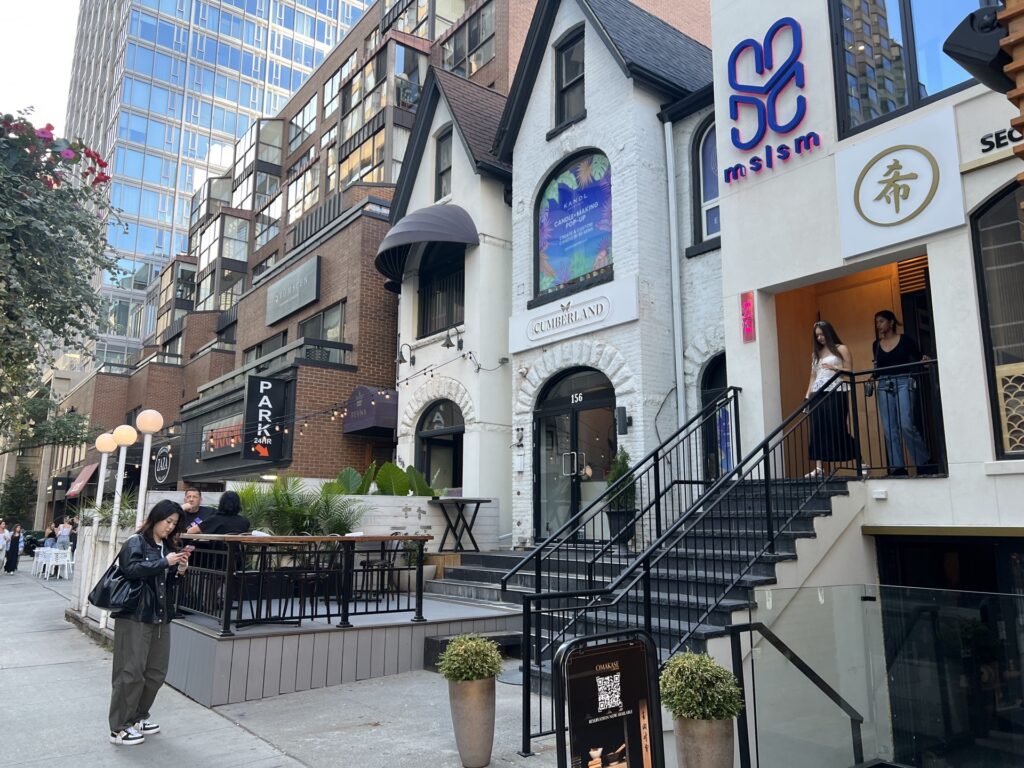
Yorkville is a high-end, but approachable district on the north side of downtown Toronto. It’s filled with twinkle light-lit patio restaurants, victorian style houses, and designer window shopping. (If you’re familiar with Chicago at all, it reminds me a lot of the Oak Street and Gold Coast area.)
I will never tell anyone to just “wander and explore” a neighborhood without specific directions. Here’s exactly how I’d recommend spending your time in Yorkville. I’d suggest starting around 1 PM if you’re planning to visit the museum or 4 PM if you’re not.
- Start on the corner of Bloor St and Yonge St and head west on Bloor. The strip from here to Avenue Road is dense with designer shopping to the likes of Hermès, Burberry and Gucci. If those stores are out of your price range (same!), it still makes for nice window shopping.
- At the end of this shopping strip, you’ll hit the Royal Ontario Museum. We cover more on this museum below, but fits great into this walking route if you have a few extra hours to spend here.
- Go north on Avenue Road for one block and then go east on Cumberland Street. This street has more approachable bars, restaurants, shops and cafes. Maybe grab a pre-dinner drink at Hemingway’s.
- Keep walking and you’ll hit Yorkville Park. It’s a cute little city park with a rock area, a pretty water feature, and lots of nice seating. I’d suggest circling back here at the end of your night. When you hit Bay Street, go north a block to Yorkville Ave.
- Head west on Yorkville Avenue. These next few blocks have the cutest buildings, high-end designer stores (like Chanel and Christian Louboutin) and a few nice restaurants.
- Stop for dinner somewhere in the area. Personally, we’d recommend Planta which is close by on Bay Street. For casual dining, consider Trattoria Nervosa or Flo’s Diner. For a fancier meal, try Sassafraz or ONE Restaurant at The Hazelton. If you can plan ahead, I’d suggest making a reservation somewhere so you don’t need to stress about finding a table.
- End your night with dessert at S’cream Ice Cream + Coffee. Grab an ice cream cone and walk across the street to Yorkville Park to eat it.

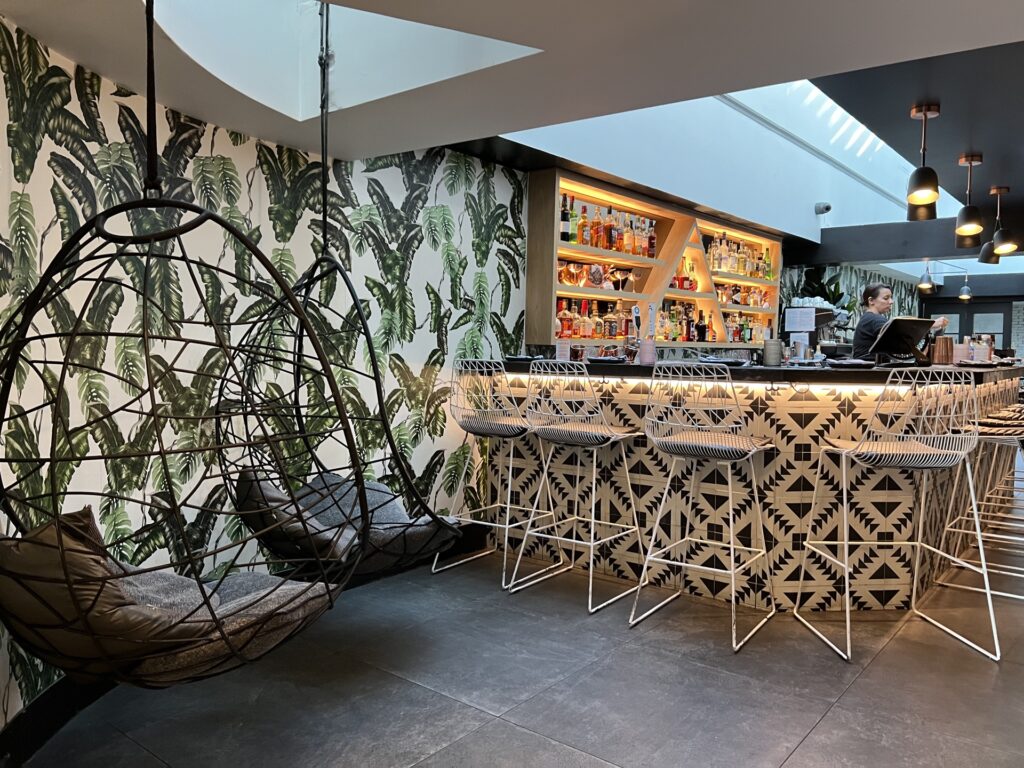
3. Graffiti Alley
- What is it: Three blocks of alley that is canvassed with really good street art.
- How to get there: Take the streetcar (probably the 310 or 510) to Spadina Ave at Queen St.
- How much does it cost: Free
- How long does it take: 30 mins – 1 hour
- When is it open: Anytime during daylight
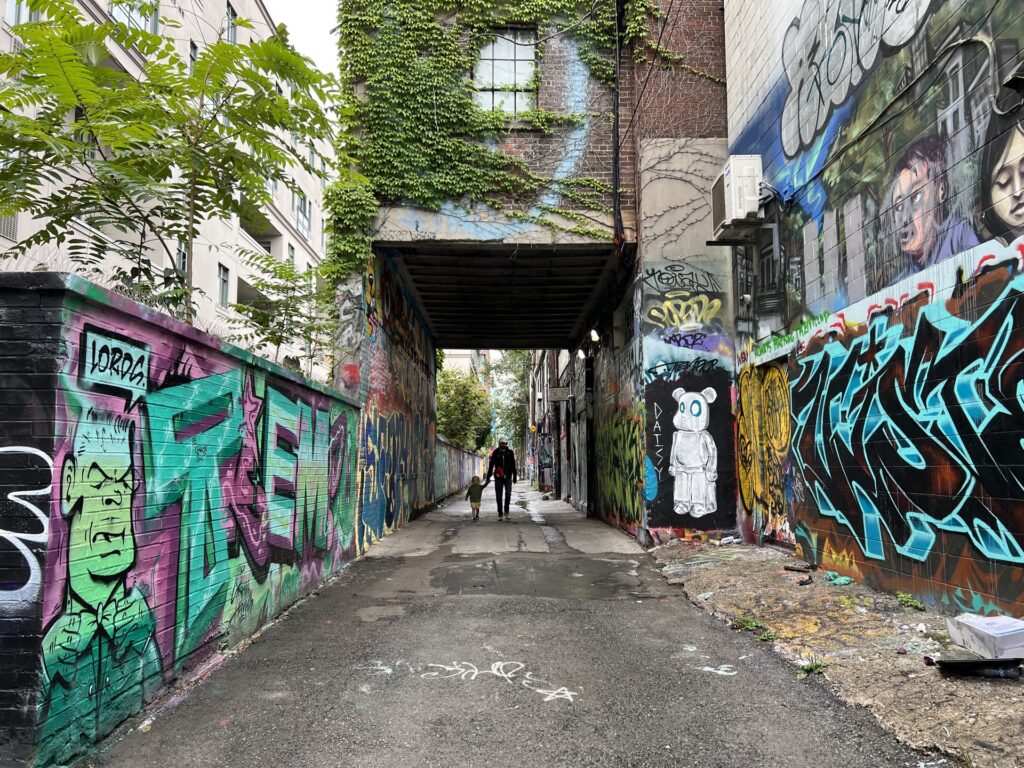
Graffiti Alley is a three-block alley that runs parallel to Queen St and Richmond St between Portland St and Spadina Ave (here). The alley and a few side streets are covered with street art, from massive murals to realistic portraits to quirky characters. It’s the only place in Toronto where street art is legal. Some of the art changes frequently while other pieces are more permanent.
The alley isn’t exactly under the radar, but it isn’t yet overrun with tourists. During our visit, we passed two other groups of people, but the alley was mostly empty. I think this is probably in large part because it’s not super easy to get to.
For that reason, I wasn’t sure if Graffiti Alley was going to be worth the time and effort to get out to. After seeing it, I can can confirm it’s definitely worth it. The streetcar was actually really easy, and the art was really cool. My toddler loved trying to figure out what the different animals were and we got some really cool photos. Our whole family really loved this spot.
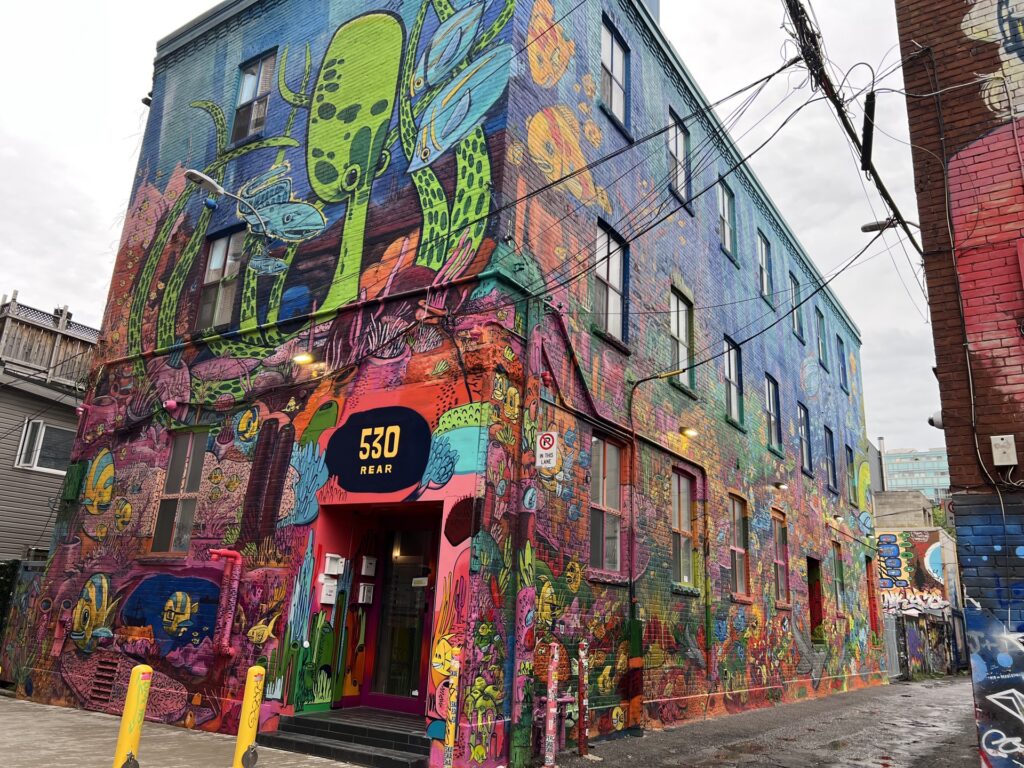
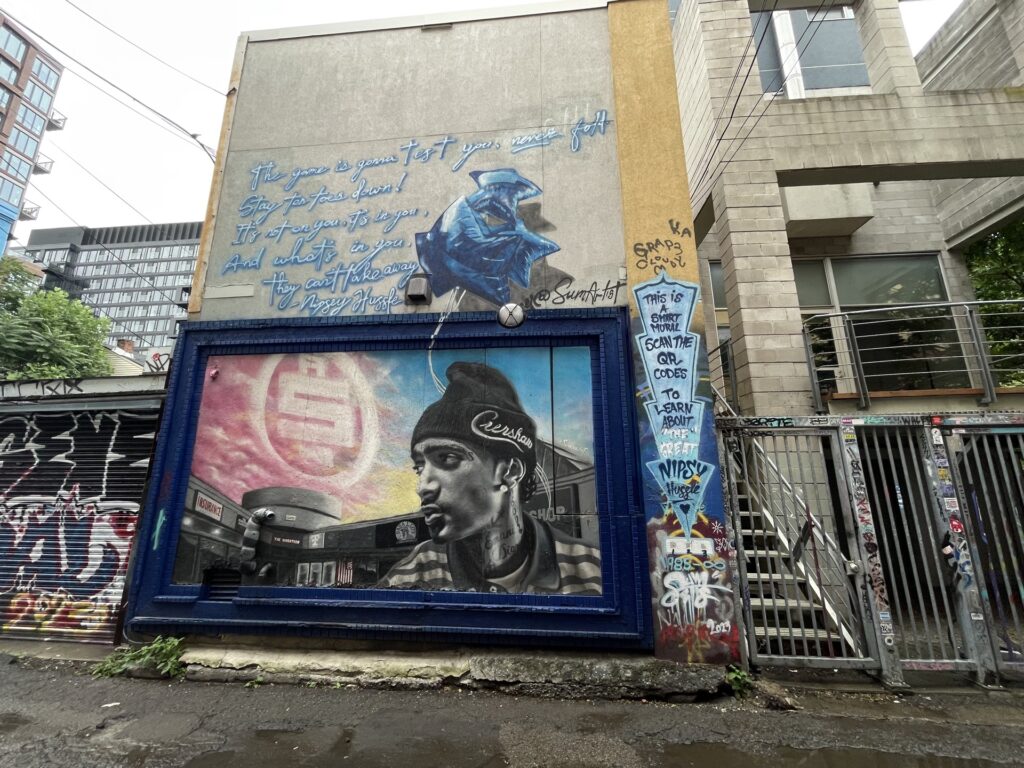
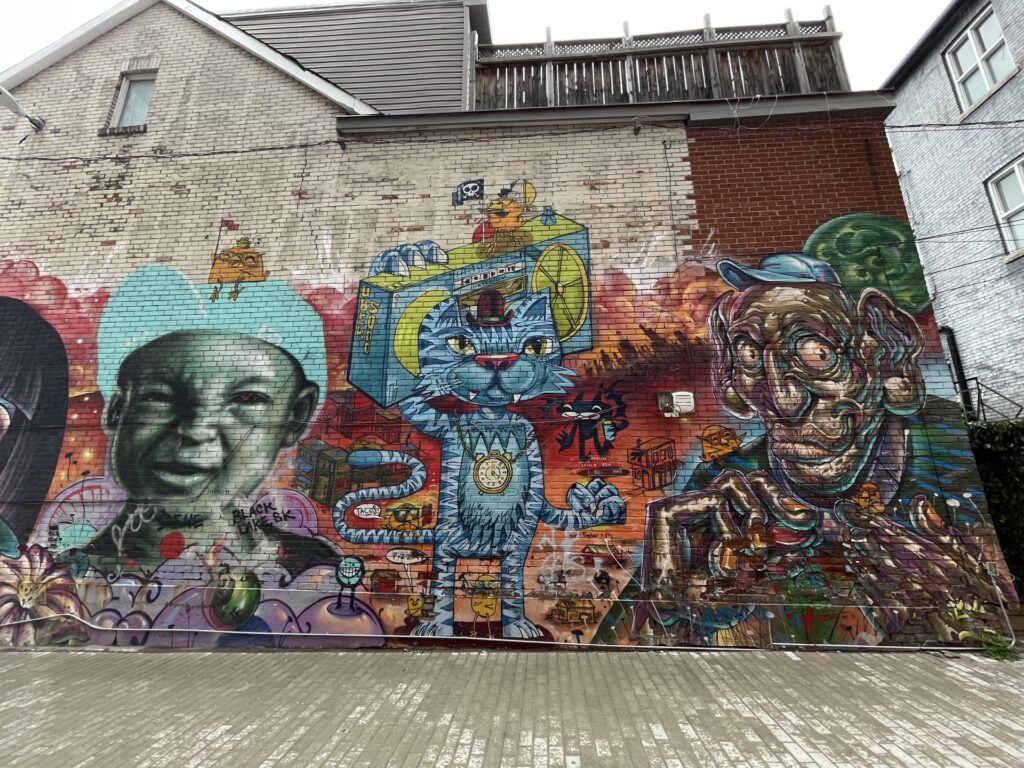
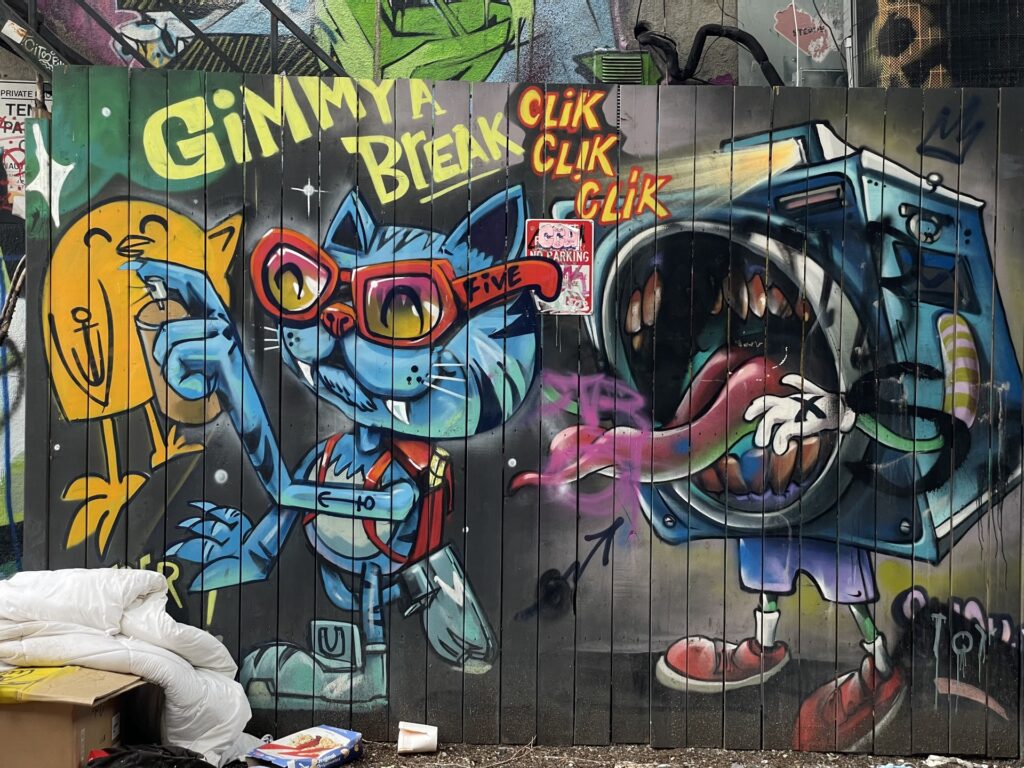
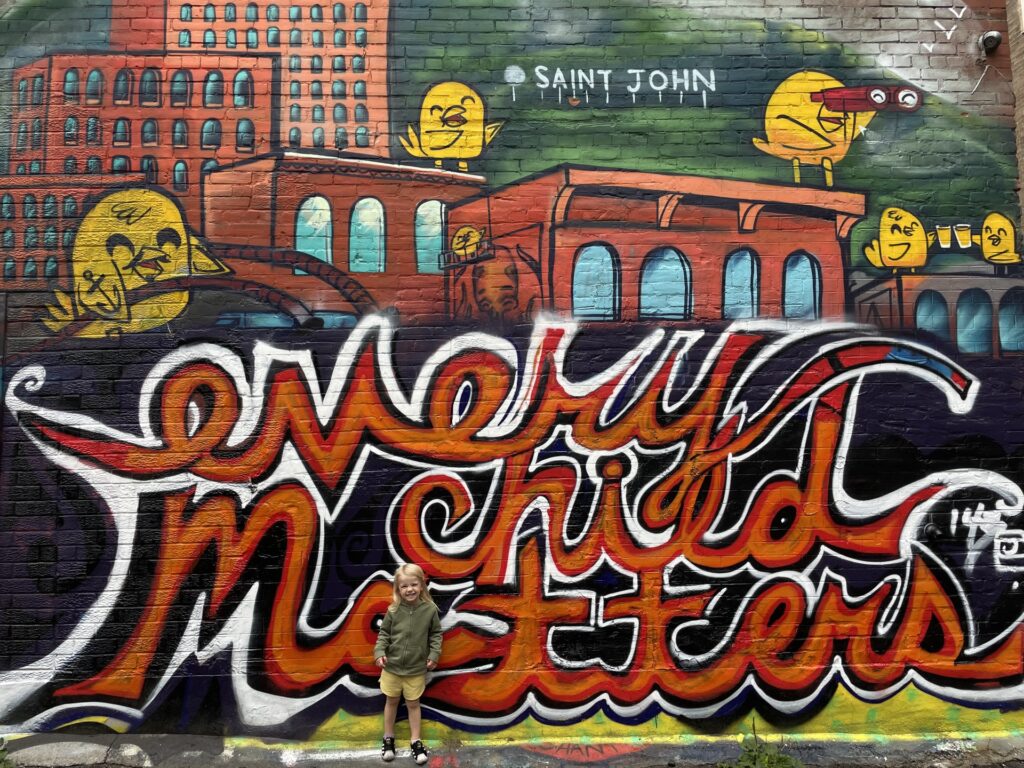
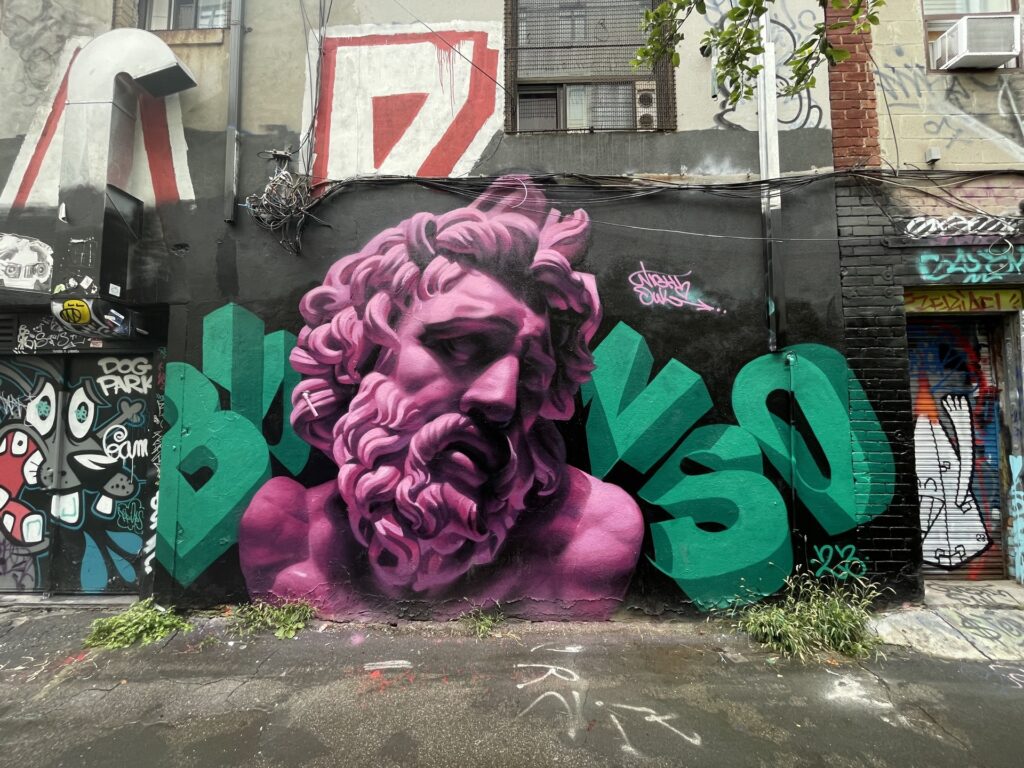
NOTE: The alley is an active alley and crosses active streets. Stay alert at intersections and watch for cars driving through.
4. Toronto Islands
- What is it: A large park spread across several small islands with skyline views, beaches and an amusement park.
- How to get there: Take a ferry from the Jack Layton Ferry Terminal
- How much does it cost: The park is free, but the ferry costs $9.11 CAD round trip ($4.29 CAD children 2-14)
- How long does it take: 2 – 3 hours
- When is it open: Roughly 8 AM to 11 AM. Check the exact ferry schedule here.
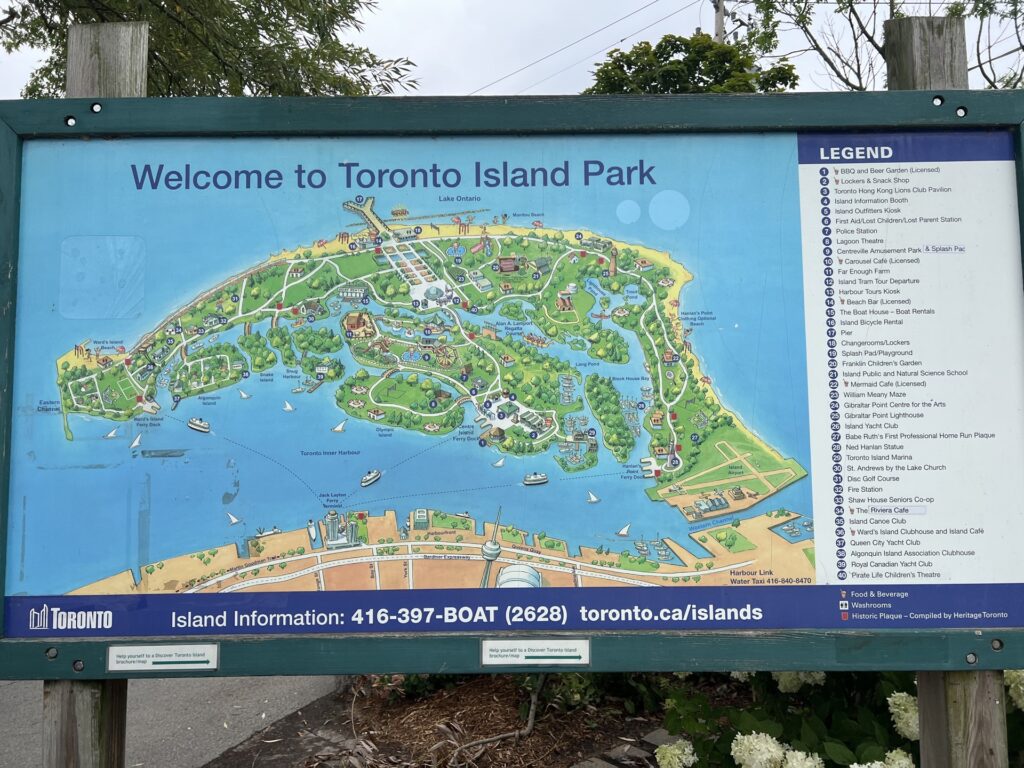
Toronto Islands refer to a collection of connected islands across the harbor from downtown Toronto. There are some residential areas on the islands, but it’s primarily public park space. Cars are allowed on the islands, but there’s not much traffic. The roads around the island are used by bikes and pedestrians as much as vehicles.
The best way to get to the islands is by ferry. The ferries run on a schedule, which you can see here, and depart from Jack Layton Ferry Terminal. You have to enter the ferry terminal from the west side through Harbour Square Park.
You can buy tickets in person, but the line was extremely long. Instead, buy your tickets online in advance. (We bought them from our phone as we walked past the long ticket queue and right onto the boat.) Tickets are not for a specific route or time.
After you scan your ticket and enter the terminal, you can queue (or board) the ferry for any route. There are three ferry routes to Toronto Islands.
- Centre Island: This is the most popular ferry stop. It’s the closest stop to the amusement park on the island, plus there’s a waterfront restaurant nearby with skyline views. Centre Island Beach, a playground & splash pad, and a large garden are just a 10 minute walk from the ferry dock.
- Hanlan’s Point: This stop is probably the least popular stop. This dock also has skyline views and is closest to Hanlan’s Point Beach. It’s also close to a small airport on the island, which is cool if you’re interested in plane spotting. Otherwise, you probably only want to pick this dock if you plan to walk the full length of the islands.
- Ward’s Island: This dock falls somewhere in the middle in terms of popularity. It has great skyline views, but not a good place to sit and enjoy them. (Just a small beach with a few chairs.) There’s a inland cafe and a playground just up the road. Ward’s Island Beach is one of the most pristine on the islands, and there’s a beautiful boardwalk along the water.
We personally chose Ward’s Island. It was nice and we had a good time at the playground and boardwalk. However, I think I would have preferred Centre Island from the looks of it compared to my experience on Ward’s Island.
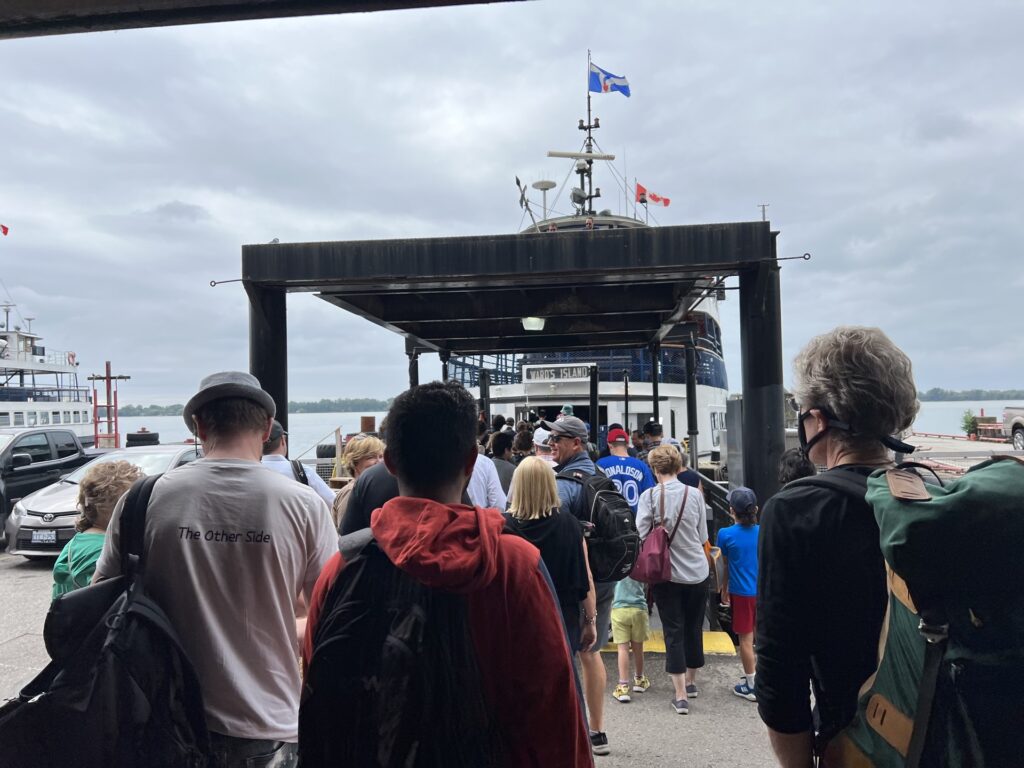
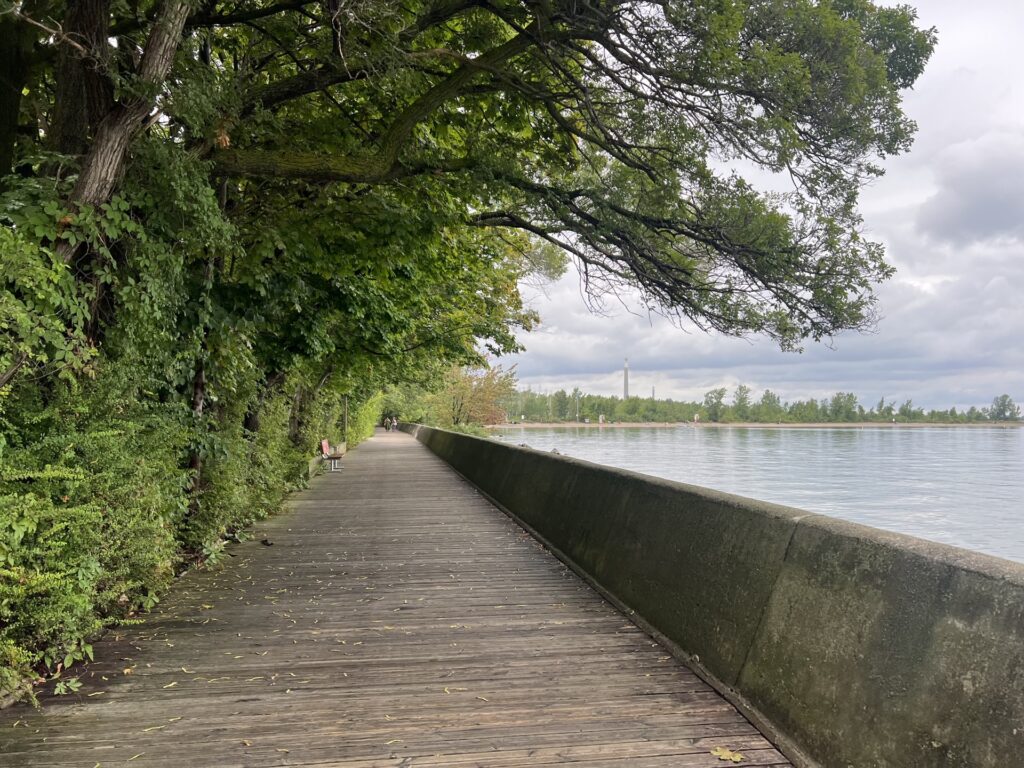
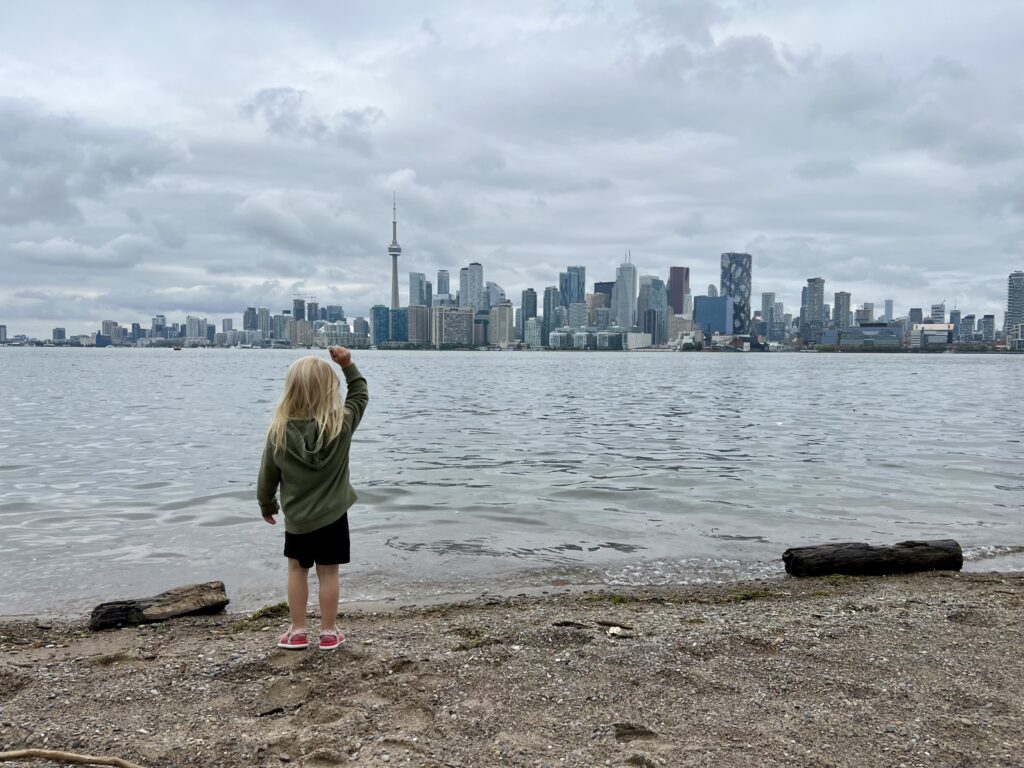
5. Nathan Phillips Square
- What is it: Open square with a large “Toronto” sign and skyline backdrop in the heart of downtown.
- How to get there: Take the Yonge-University line to Queen or Osgoode
- How much does it cost: Free
- How long does it take: 30 minutes (longer if you go ice skating in the winter time)
- When is it open: All the time
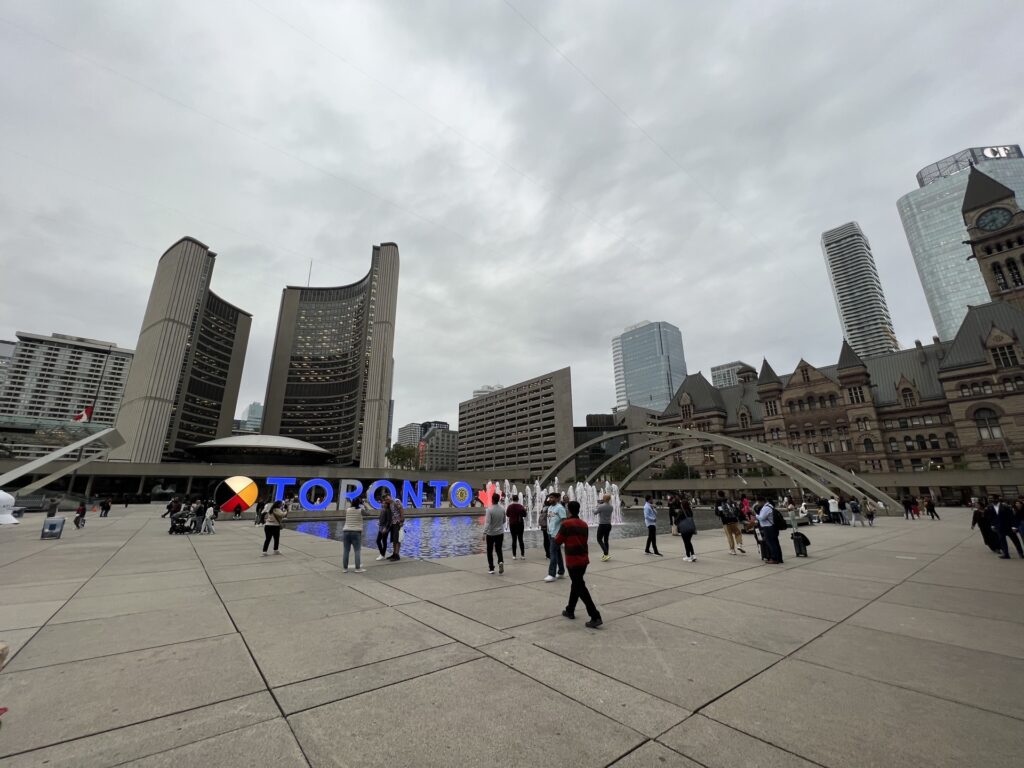
Nathan Phillips Square is a city square with a pond in the middle and large “Toronto” sign. Like any square, it can be what you make of it. In the winter time, this square becomes an ice rink and is much more popular. We visited in the summer, and it was still lively with tourists and locals alike, relaxing on a warm evening.
For many, this will be a quick stop for a photo. However, there is plenty of seating nearby and above if you’d like relax and watch the city go by. I wouldn’t say you had to go too far out of your way to come here, but it’s worth stopping by if you’re in the area. (If you’re looking for dining before or after, we highly recommend Cafe Landwer.)
From Nathan Phillips Square, it’s a short walk to Yonge Street and up to Yonge-Dundas Square. There’s a large shopping mall and street-side stores, along with a handful of (mostly chain) restaurants and bars. Yonge-Dundas Square is referred to as the “Times Square of Toronto,” but I would argue that it’s not even close. This walk and square didn’t make my list, but if you’re coming from Nathan Phillips Square it’s a fine thing to do next.
6. St. Lawrence Market
- What is it: Two-story food hall and shopping market.
- How to get there: Take the Yonge-University line to King and walk 10 minutes.
- How much does it cost: Free to enter, but food and other items are available for purchase.
- How long does it take: 1.5 hours
- When is it open: Tuesday through Friday 9 AM – 7 PM / Saturday 7 AM – 5 PM / Sunday 10 AM – 5 PM / Closed Mondays
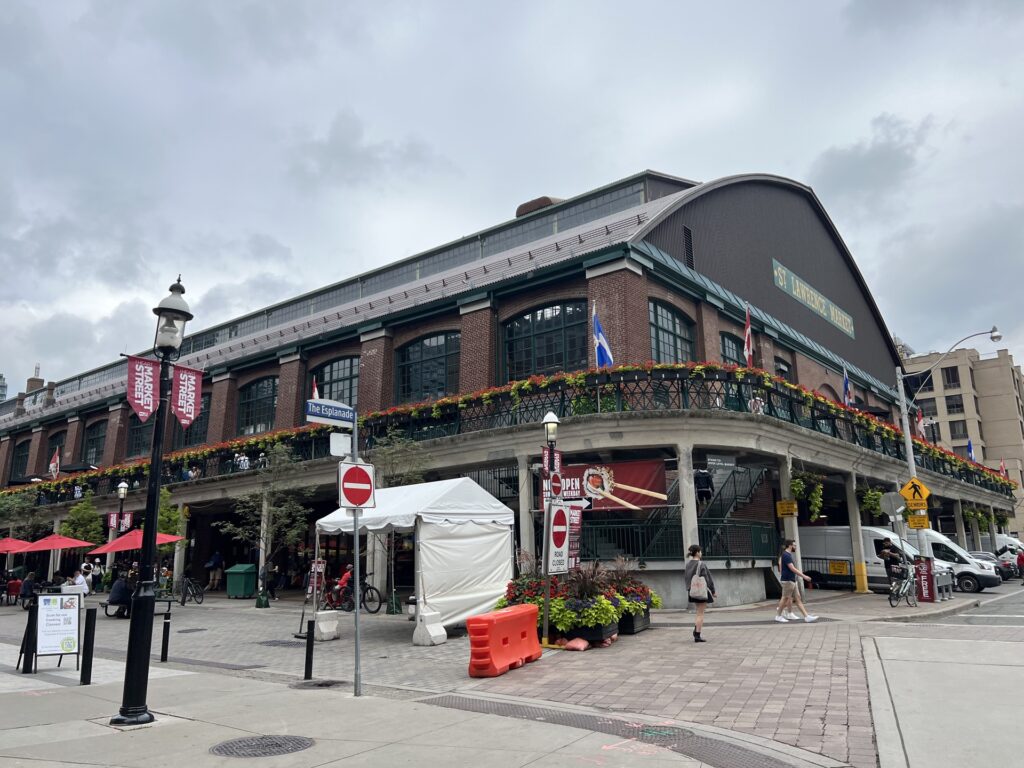

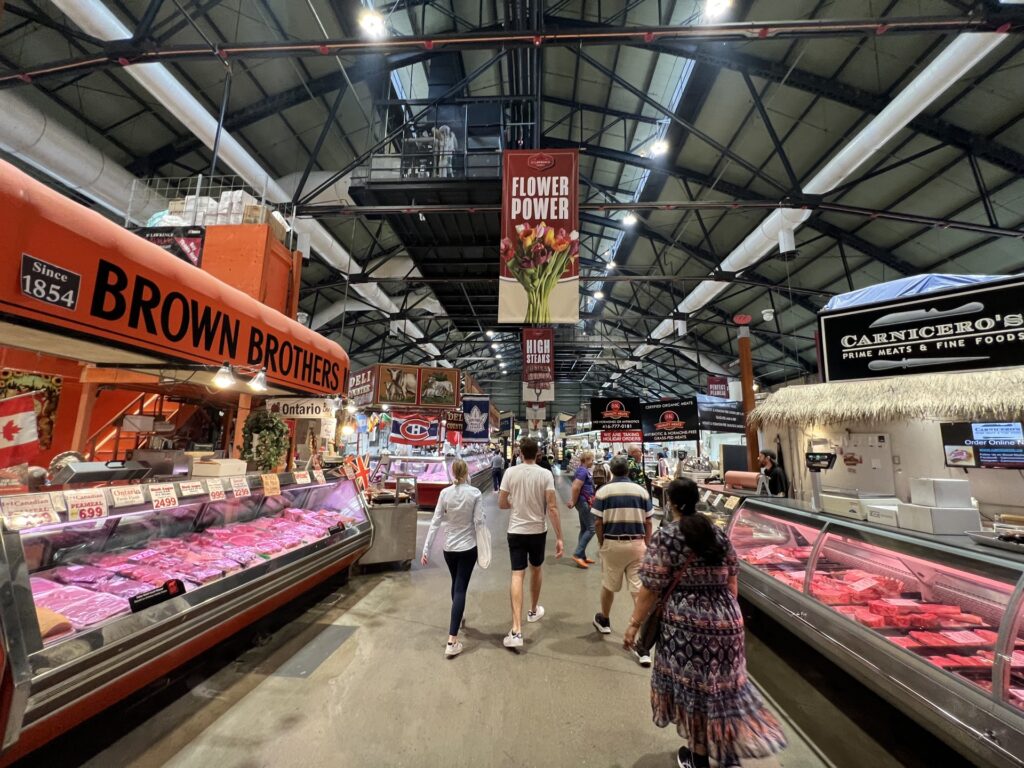
St. Lawrence Market is part food hall (serving prepared meals and baked goods) and part shopping market (selling produce, meat, flowers, etc). I would call the latter “farmer’s market style,” but St. Lawrence Market also has an actual farmer’s market on Saturdays (5 AM – 3 PM). In addition to food vendors, there is also a handful of shops selling trinkets, souvenirs and kitchen gadgets.
It’s a fun place to get lunch and spend part of your afternoon. It’s a very popular market, so the food lines can get long midday. However, they’re used to long lines so they actually move really quick.
I’m sure there are lots of good restaurants in the market, but I’m not sure any can beat Uno Mustachio. When I tell you this is the best eggplant parm sandwich I’ve ever had in my life, I’m not being dramatic. (And I don’t even usually like eggplant!)

If you like to plan your meals in advance, check out the official website for the complete list of vendors or this great guide on what to eat at St. Lawrence Market.
7. Royal Ontario Museum
- What is it: Natural History Museum in the Yorkville neighborhood
- How to get there: Take the Yonge-University line to Museum Station
- How much does it cost: $26 CAD ($16 CAD children 4 – 14)
- How long does it take: 2-4 hours
- When is it open: Tuesday through Sunday 10 AM – 5:30 PM / Closed Mondays
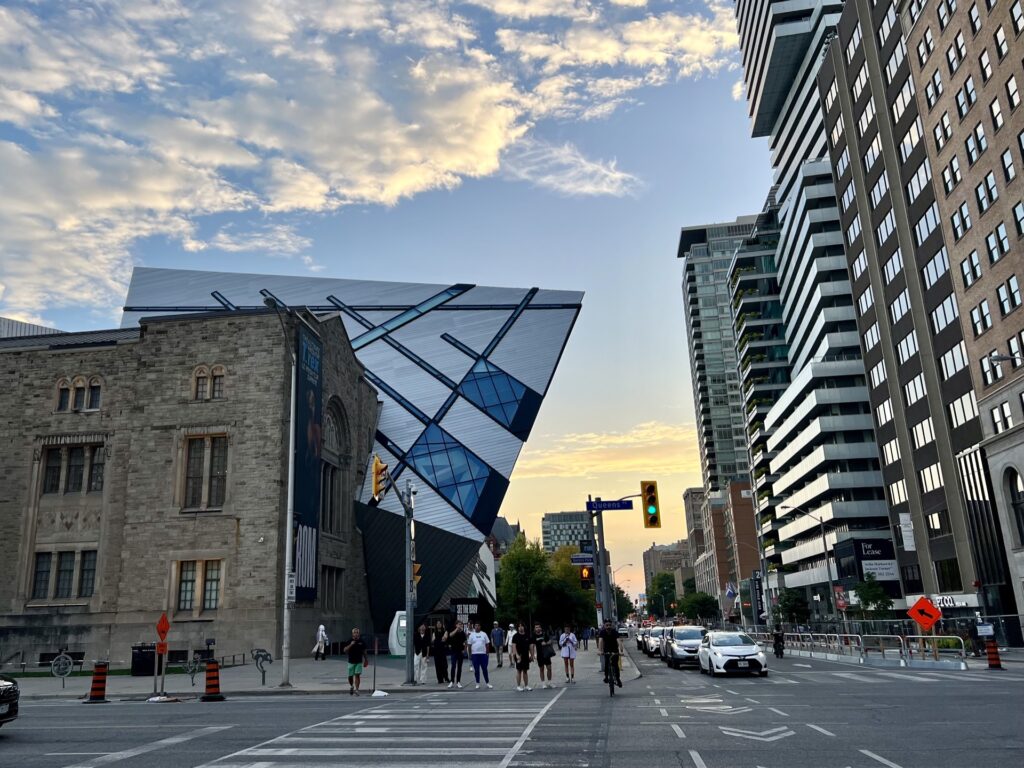
The Royal Ontario Museum is one of the best museums in Toronto. It’s great for visitors of all ages, but it’s particularly appealing for those with younger kids. They have a dinosaur exhibit, a children’s play area, a great exhibit on mammals, an interactive Dawn of Life life exhibit, and so much more.
Like most museums, it can be what you make of it. It’s possible to spend an entire day here exploring each gallery and exhibit. If you’re short on time though, you can see the highlights in just a few hours. We came right after our kid woke up from a nap and only had 2 hours before it closed. While a tad rushed, we were still able to see everything we really wanted to see.
Now, the Royal Ontario Museum is a good natural history museum … but it is still a natural history museum. If you’ve been to other natural history museums in other big cities (e.g. The Field Museum in Chicago or the American Museum of Natural History in New York City), you might not be wowed.
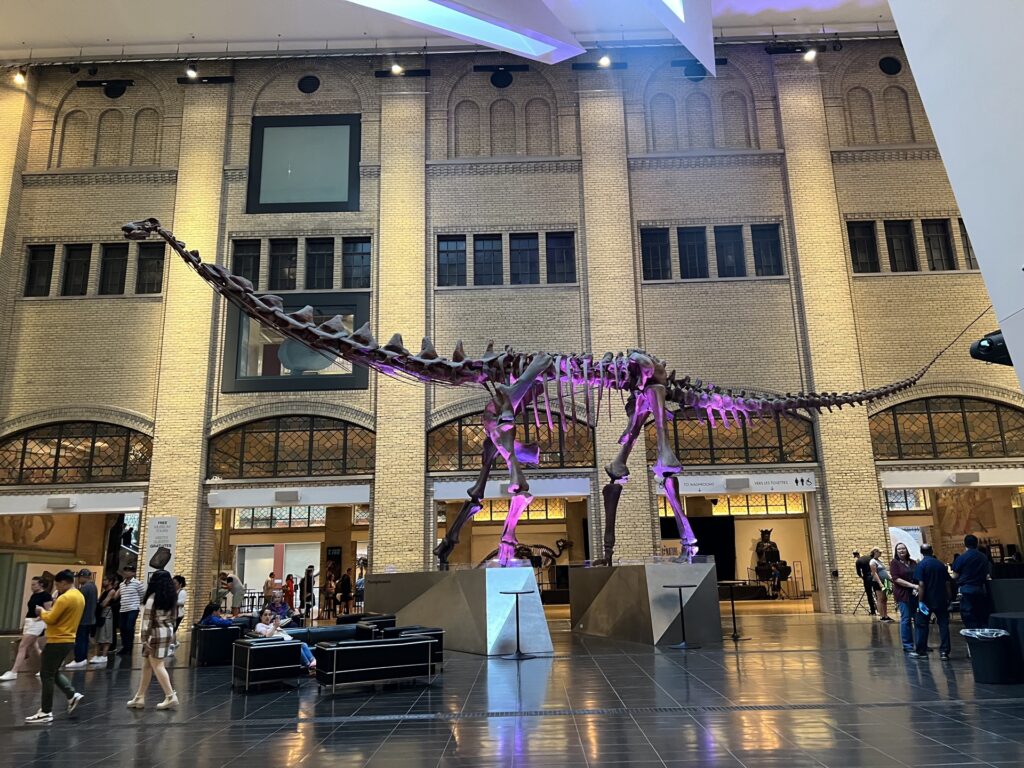
8. CN Tower
- What is it: Iconic tower structure with an observation deck and restaurant
- How to get there: Take the Yonge-University line to Union Station and walk 10 minutes
- How much does it cost: $43 – $53 CAD ($30 – $40 CAD children 6-13)
- How long does it take: 1-2 hours
- When is it open: Daily, 9:30 AM – 9:30 PM
For the best views of Toronto, head to the top of the city’s icon CN Tower. The main observation deck is the equivalent of the 114th floor. For a bit more, you can visit the Sky Pod, which is 33 floors higher than the main observation deck.
If you’re interested in the observation decks, do it early in the day and avoid weekends if you can. I’ve read many accounts of visitors who spent an hour or more waiting in lines to get in and up, even with a scheduled timed entry ticket. Morning waits will be much shorter.
There is also a rotating restaurant inside CN Tower, called 360. The full rotation takes 72 minutes, so you can experience the view from every angle throughout your meal. (Reservations recommended.) Restaurant guests can skip the main queue and head right up to the restaurant. Patrons also receive general admission access to the observation deck at no extra cost. There’s just one catch.
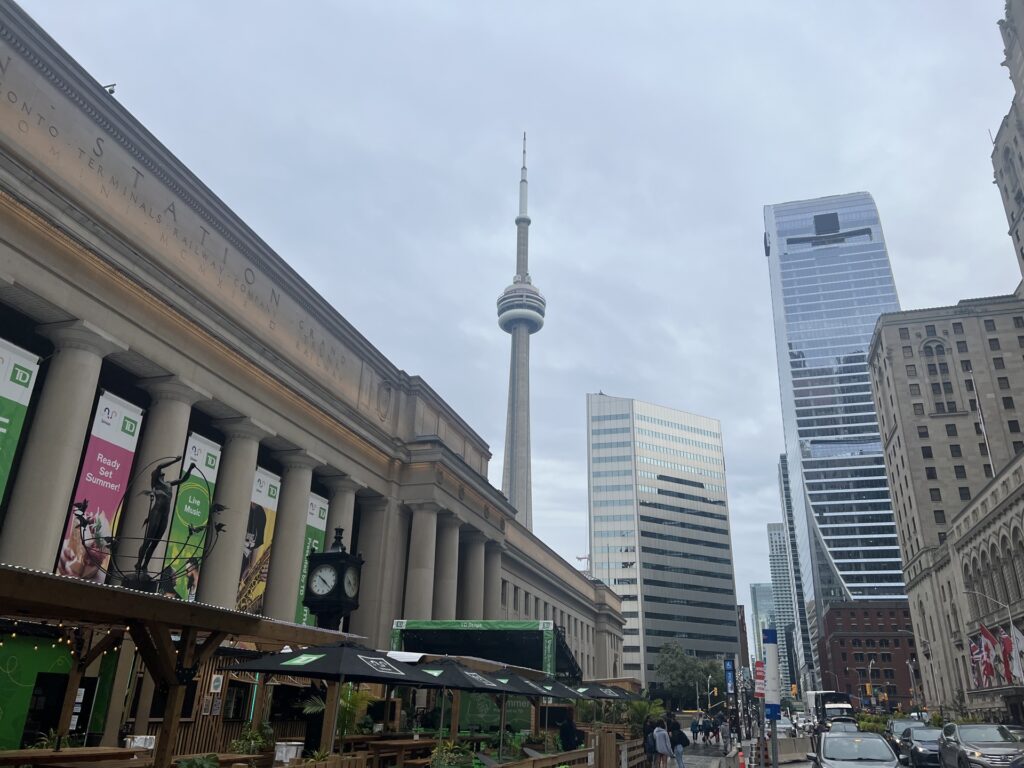
There is a spending minimum of $75 CAD per person ($40 CAD children 4-12) at the restaurant. When you consider the fact that general admission for the observation deck costs about $45 CAD, the extra $30 CAD for your meal doesn’t actually seem so bad.
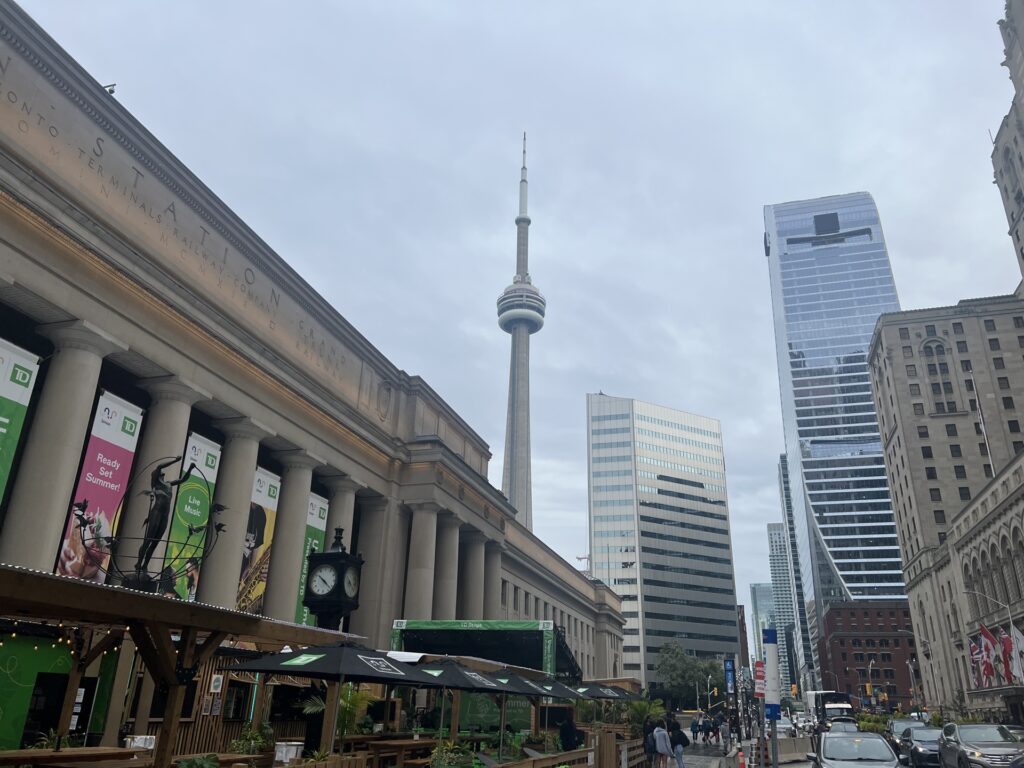
9. Distillery District
- What is it: Artsy pedestrian neighborhood that’s a hot spot for shopping and dining
- How to get there: Take the streetcar (504, 504A, 504B) to Distillery Loop
- How much does it cost: Free to walk around, but budget for a meal or snack
- How long does it take: 1 hour (+ longer if you plan to eat)
- When is it open: The general area hours are 10 AM – 7 PM, however each restaurant and shop has their own operating hours which are usually later than that.

The Distillery District is a hip, pedestrianized neighborhood on the southeast edge of downtown. A collection of restaurants, bars, art galleries and boutiques have taken up residence in a former distillery, making it a popular spot for locals and tourists a like.
The neighborhood is most bustling in the afternoon and evening. Most people flock to the area for a meal, and then stick around to stroll the streets and pop into the shops. Many restaurants take reservations, which is a good idea if you’re set on eating at a busy time. You can find the full list of restaurants here.
The Distillery District also hosts a series of events, which range from live entertainment, popup markets and workshops. The area is home to a Winter Village and Christmas market from mid-November through New Year’s Eve.
10. Casa Loma
- What is it: History and art museum inside a castle
- How to get there: Take the Yonge-University line to Dupont and walk 10 minutes
- How much does it cost: $45 CAD ($29 CAD children 4-13)
- How long does it take: 3 hours
- When is it open: Daily, 9:30 AM – 5 PM
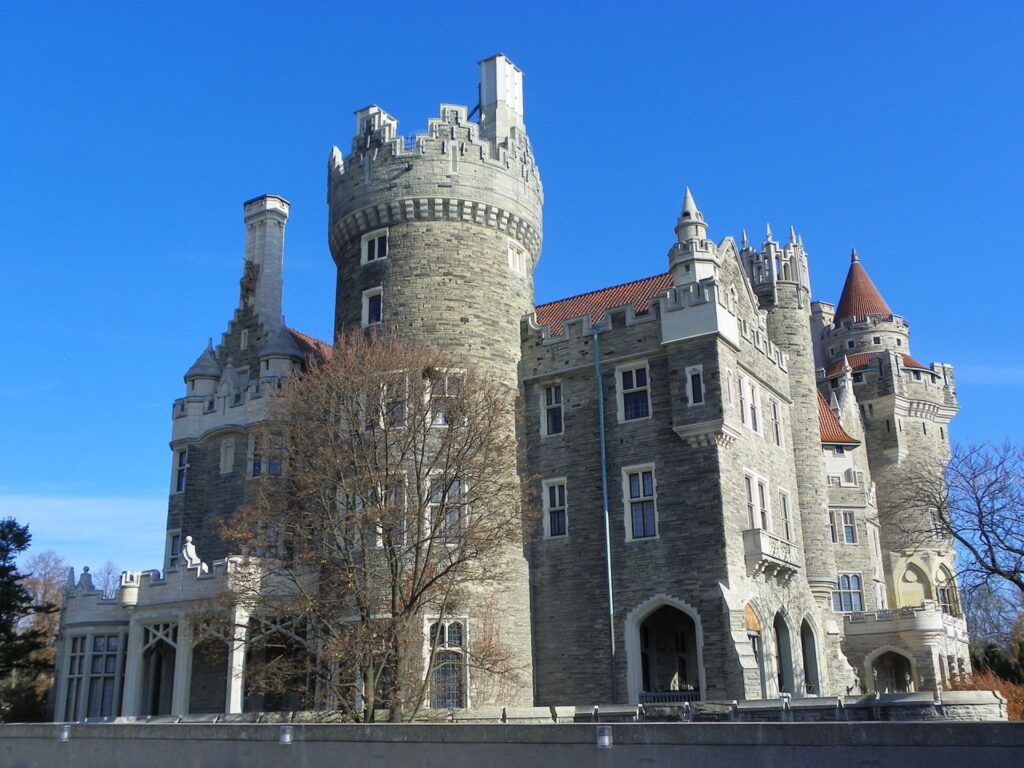
Casa Loma is a castle on the north end of downtown Toronto. It’s one of the only castles in North America, but not in the historic sense. The castle was built in 1914 as a homage to the medieval castles of Europe. Today, the castle is revered for its architecture, tower views, manicured gardens and immaculate rooms.
The castle is very popular, and gets crowded midday and on weekends. Because there are so many small rooms and passages, crowds can make the experience slow and unpleasant. Arrive early to beat the crowds.
Casa Loma also hosts a variety of seasonal events, including a summer symphony series, escape rooms, and more. Special events require separate tickets. You can learn more about those here.
BONUS: Day Trip to Niagara Falls
This is a bonus, because you can’t count something outside of Toronto as a thing to do in Toronto. However, day trip to Niagara Falls is a great addition to any Toronto itinerary.
There’s a daily train that runs between Toronto and Niagara Falls. It takes about 2 hours and costs around $70 CAD round trip (prices vary based on when you book). The train schedule gives you just enough time to see Niagara Falls, do some of the experiences (like the boat ride and Journey Behind the Falls), see a bit of the town, and make it back to the station in time for your return.
If you’ve never been to Niagara Falls, I’d highly recommend it while you’re nearby. It’s an incredible experience and worth the journey.
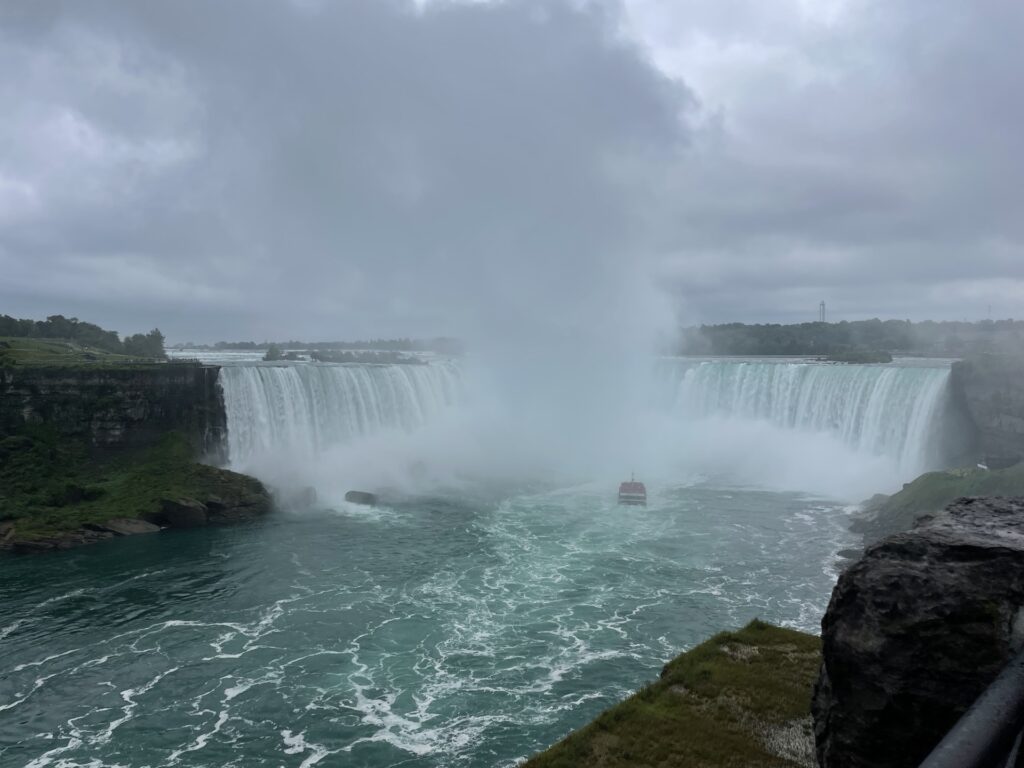
A Few More Things to do in Toronto
- Visit the Hockey Hall of Fame. The museum is downtown and open daily.
- Watch a Toronto sporting event. The Blue Jays (baseball) and Maple Leafs (hockey) have stadiums in the heart of downtown Toronto.
- Stroll through Chinatown. You’ll find restaurants of course, but also lots of interesting markets and shops. (It’s also not too far from Graffiti Alley)
- Explore Kensington Market. This eclectic neighborhood is just north of Chinatown. You’ll find boutiques, thrift shops and a wide array of restaurants. The market is popular all year, but one of the best times to go is for Pedestrian Sundays on the last Sunday of the month during the summer.
- Take a walk through Toronto Music Garden. It’s a beautiful garden park with great water and city views. You can find it on the west side of the harbor parks.
- Wander through Queens Park. It’s a large park that is mostly surrounded by the University of Toronto Campus. It’s perfect in the fall for back-to-school, autumn vibes.
Sample 3-Day Toronto Itinerary
If you have three days to spend in Toronto, here’s how I’d recommend stringing together most of the items listed above. We were traveling with a toddler who had to nap for 2 hours in the middle of the day, so our schedule wasn’t quite identical to this but it was very close.
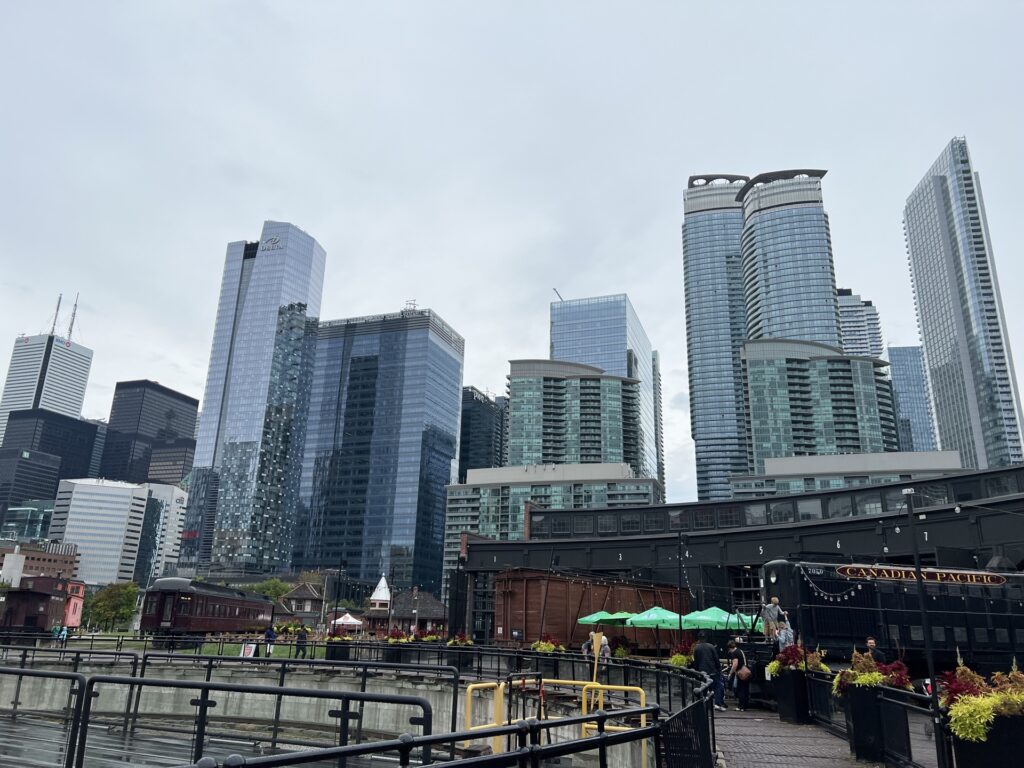
Arrival Day – CN Tower
- Dinner at 360 (the revolving restaurant inside CN tower)
Day 1 – Downtown & Yorkville
- Coffee at Fahrenheit Coffee
- Walk down Graffiti Alley
- Streetcar to Roundhouse Park
- Toronto Railway Museum (Closed Mondays & Tuesdays) & Miniature Train Ride
- Lunch at Steam Whistle Tap Room
- Take the metro train to Royal Ontario Museum (closed Mondays)
- Yorkville Neighborhood Walk (see walking route above)
- Drinks at Hemingway’s
- Dinner at Planta
Day 2 – Niagara Falls Day Trip
- Train to Niagara Falls
- Journey Behind the Falls
- Waterfall Viewing
- Clifton Hill
- Niagara City Cruise to the Falls
- Train back to Toronto
For details, be sure to check out our complete planning guide for a Niagara Falls Day Trip From Toronto.
Day 3 – Toronto Island, St. Lawrence Market, Distillery District
- Coffee at Dineen Coffee Co.
- Ferry to Centre Island
- Walk Avenue of the Island toward Centre Island Beach, through the garden, out to the pier and back
- Lunch at St. Lawrence Market, specifically Uno Mustachio (closed Mondays)
- Walk the Esplanade to the Distillery District
- Shop & explore the Distillery District
- Dinner at Madrina Bar y Tapas (reservations) or El Catrin Destileria (reservations)
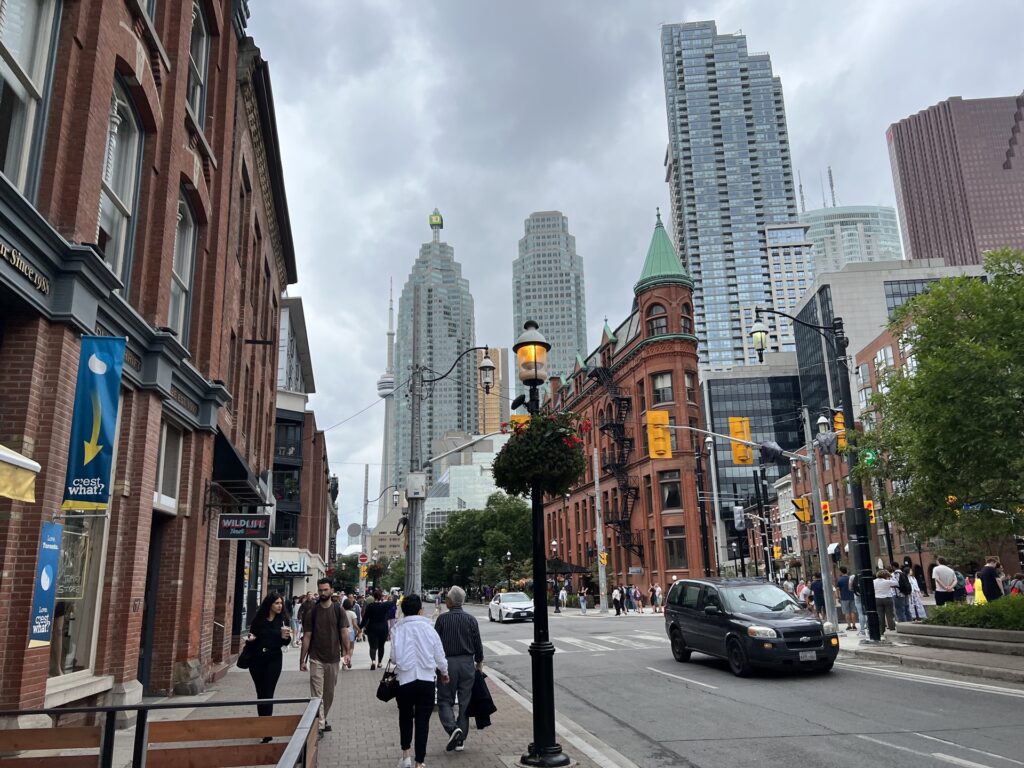
Tips for Visiting Toronto
- Visit in September. You’ll miss the summer crowds, the weather is usually great and most attractions will still be operating at full summer hours.
- Bring your Global Entry card. If you are traveling from the US and have Global Entry, be sure to bring your physical card. For many flights from Toronto to the US, you will go through US customs in Toronto before you fly (versus upon arrival in the US). To benefit from Global Entry at the Toronto airport, you’ll need your physical Global Entry card.
- Bring a credit card that can tap. All Toronto public transportation has tap-to-pay, so be sure you have a card with that functionality. Specifically, try to bring one with no foreign transaction fees, like Chase Sapphire Preferred or AmEx Gold.
- Don’t bother getting Canadian cash. Pretty much everywhere in Toronto accepts credit cards. The only time we needed cash in all of Canada was to buy a bus ticket at Niagara Falls, and they took USD. Stick to that no-fee credit card and don’t worry about getting any Canadian currency.
- Book tickets online in advance. Most attractions (including the Toronto Island Ferry, Royal Ontario Museum and Casa Loma) sell tickets online in advance. Even if you buy tickets from your phone at the door, you can skip the ticket queue and enter quicker.
- Pack at least 2 pairs of shoes. If you’re even remotely considering the day trip to Niagara Falls, make sure you have at least one extra pair of shoes. Some of the attractions there get you pretty wet, and you don’t want wet shoes for the rest of your trip.
- Make plans around neighborhoods. Toronto has some cool neighborhoods, like the Distillery District, Kensington Market and Yorkville. These areas are best experienced if you make an entire afternoon or evening out of them. Make plans for a meal, grab a coffee or a cocktail, pop into the stores. If you’re just walking through these areas, you’ll speed through them quickly and it might not feel like it’s “worth it.”
- Bring a packable tote. I bring these packable totes every time I travel, and every time I use them. I keep them in my fanny pack or in my pocket at all times. If I have leftovers from dinner, buy a souvenir or want take off my coat inside, I have a bag handy.
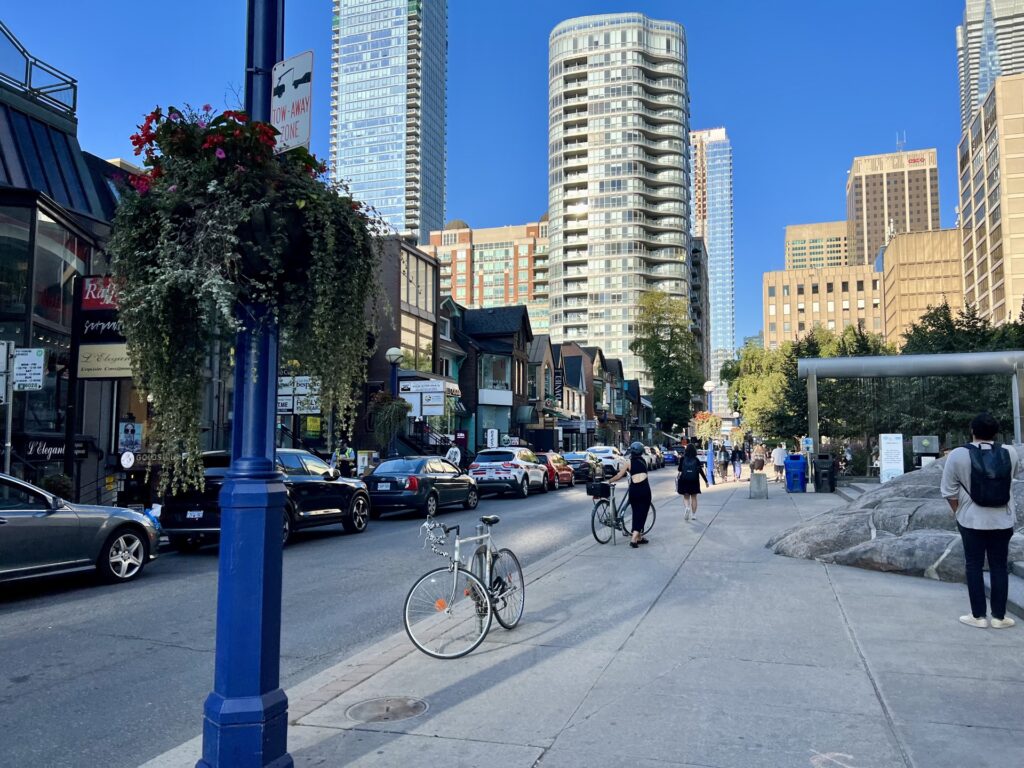
More from This Trip
- American Airlines Main Cabin Extra Review
- 10 Best Things to do in Toronto | City Guide + Sample Itinerary
- Perfect Niagara Falls Day Trip From Toronto
- 10 Things To Do In Vancouver On Your First Visit
- Stanley Park Itinerary – How to Spend 1 Day in Vancouver’s Largest Park
- Air Canada Business Class Review – A321 from YVR to YYZ
- Air Canada Business Class Review – Toronto to Chicago
If you’re planning a visit to Canada, you might also be interested in our Flight Review of Business Class on Air Canada 787.
